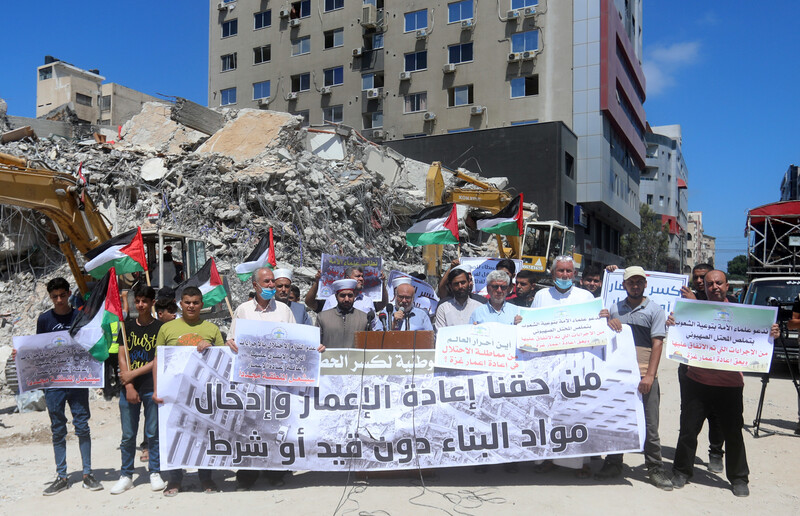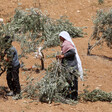Rights and Accountability 21 July 2021

Palestinians demand an end to the siege on Gaza in a protest in front of the rubble of al-Jalaa tower, which had housed offices of the Associated Press and Al Jazeera before it was bombed by Israel in May.
APA imagesAs the Muslim holiday Eid al-Adha begins, Gaza is still reeling from Israel’s 11-day bombing campaign in May.
The Israeli assault started just before the Eid al-Fitr holiday marking the end of Ramadan, and ended with the killing of at least 245 Palestinians in Gaza, including 63 children.
The bombs may have stopped dropping. But the devastation continues.
Palestinians in the coastal enclave have been left to rebuild and recover from widespread destruction while living under a 14-year Israeli blockade that appears to hamper this process on certain political negotiations and outcomes.
Since the assault, “only food, medical supplies, fuel, animal fodder and ‘raw materials for critical industries’ have been allowed into the territory,” The Times of Israel reported.
Israeli occupation authorities have used their “absolute control” over maritime, aerospace and land entry and exit points “to achieve political goals and objectives,” according to the Gaza-based rights group Al-Mezan.
Israeli politicians have suggested that they intend to reduce the amount of cash they allow into the Strip, including from Qatar.
Israel’s public security minister Omer Barlev reportedly suggested that Qatari aid “won’t enter as dollars in suitcases that go straight to Hamas” but rather that “the mechanism will largely operate through the United Nations, and will enter as food vouchers or humanitarian assistance, not cash.”
A Jerusalem Post editorial said Israel had been “seeking to condition aid” on the release of two Israelis held by Hamas, as well as the bodies of two others.
Propaganda
On 14 July, Israeli authorities allowed the entry of commercial goods, including clothes, for the first time since its assault, according to Safa News Agency.
This came after COGAT, the bureaucratic arm of Israel’s military occupation – the wards of the Gaza ghetto – announced the decision to ease imports and exports into the Strip.COGAT boasted of extending the permitted fishing area from nine to twelve nautical miles off of Gaza’s coast – still way short of the 20 nautical miles stipulated by the Oslo accords of the 1990s.
The post announcing the change on 12 July stated the decision was made “following the recent security calm” and after “acquiring political approval.”
The entry and exit of goods at the Kerem Shalom commercial crossing would also be eased, COGAT added.
The group said the providing of such services, which benefit civilians, is “conditional on maintaining security stability.”
Israeli rights group Gisha said COGAT’s proposals are “nowhere near enough” to meet Gaza’s needs or “mitigate the harm” caused by the blockade.
While Israel permitted the entry of medical equipment, fishing, school supplies, shoes and other items into Gaza, it is still barring thousands of materials, including construction equipment, raw materials and spare parts, Gisha said on Wednesday.
What does it mean to be blockaded?
It can seem a foreign concept to many to even contemplate a “siege” or “blockade.” Some do not understand how exactly Israel’s policy makes “normal life” impossible for Palestinians in Gaza, even when it’s not bombing it.
The siege amounts to a war crime, Al-Mezan has said, since it is collective punishment of two million Palestinians living in Gaza, about half of whom are children.
Earlier this month, Gaza’s electricity distribution company reported that less than 55 percent of electricity needs were met. Electricity is available for an average of just 13 hours per day across Gaza this year, according to UN monitoring group OCHA.
And this number assumes that all electricity lines from Israel are active, which Al-Mezan noted is rare.
Many crucial services underpinning daily life are affected by electricity shortages, from waste treatment through water services to the health sector.
Israel has also been barring the import of almost all raw materials and equipment for reconstruction, with some minor exceptions like paper and detergents, Al-Mezan said.
Israel’s bombing of residential neighborhoods in Gaza has completely destroyed the homes of 8,500 people, the group said.
One in eight Palestinians in Gaza are unable to repair damages caused by bombings to their homes due to Israel’s refusal to allow reconstruction materials into the enclave.
Gisha pointed to reports claiming that Israel is conditioning Gaza’s reconstruction efforts on certain political negotiations with Hamas.
Textiles, furniture, farming and fishing are some of the major industries impacted by the ongoing shortage of materials, according to Gisha.
“Even acquiring a mattress is now difficult,” Al-Mezan said, because sponge factories cannot operate.
Gaza’s economy, already battered before Israel’s assault, has been further devastated by Israel’s latest aggression.
Prices have risen in Gaza’s market as a result of severe restrictions, as have job losses.
Gaza already had one of the world’s highest unemployment rates – around 50 percent even before Israel’s latest offensive. This number is expected to rise.
Gaza is facing “unprecedented” levels of poverty, says Al-Mezan, and the vast majority of residents – 68 percent – are food insecure.
Around 70 percent of families in Gaza are receiving some form of assistance.
During the assault, Israel also targeted 24 medical facilities in Gaza, according to a report by Al-Mezan.
And starting the second day of the assault and for its duration, Israel’s military authorities refused to let any patient leave Gaza through the Erez checkpoint to receive treatment outside of the Strip.
Al-Mezan said several people died as a result.
The Erez checkpoint is only one of two points of entry and exit from Gaza, and the only one between Gaza and Israel and the occupied West Bank. Israel has largely kept it closed – barring some exceptions – since March 2020 under the guise of the COVID-19 pandemic.
The other is Egypt’s heavily secured Rafah crossing, which is Gaza’s only passage to the outside world not directly controlled by Israel, but which is only open – when it is open – to passengers, not goods or for commerce.
Egypt aids Israel in denying to Palestinians their freedom of movement in and out of Gaza.
This is the status quo of Israel’s siege on Gaza – a nearly unliveable reality that Palestinians in the Strip return to after every round of Israeli bombing.
Sometimes restrictions on imports and exports are tightened or loosened. Sometimes the permitted nautical miles off of the Gaza shore are extended or reduced.
But so long as Israel’s siege on Gaza continues, any drip-feed changes will alleviate Palestinian suffering only in the very short term.
Without any meaningful change to end the blockade, the violence of the status quo persists.




